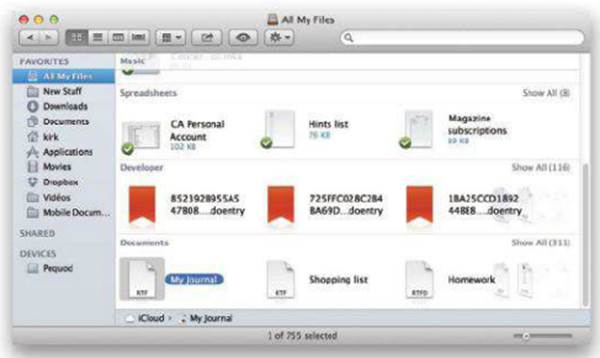Here’s one way to find your iCloud files:
Go to yourusername/ Library/ Mobile Documents and type something – anything –
in the Finder window’s search field. Make sure Mobile Documents, not This Mac,
is selected in the Search bar. Next, click on the plus-sign button (+), and
choose Kind Is Document. Now erase whatever you typed in the search field. All
of your iCloud documents should display. Click on Save, and check Add To
Sidebar to add this search to your Finder window sidebars.

Find
iCloud Documents via Smart Search
Switch to iCloud via Open and Save Dialog Boxes
For a long time, you’ve been able to access
key system folders from an Open or Save dialog box via shortcuts: Command-D for the desktop,
Command-Shift-H for your home folder, and so on. (The Finder’s Go menu lists
the shortcuts.) Now, a new shortcut lets you jump directly to iCloud, at least
in apps that support it: Command-Shift-I. So if you see the folders on your Mac
in an Open or Save dialog box, press this shortcut to go directly to iCloud.
Disable iCloud Open and Save Dialog Boxes
If you use iCloud for some of its features
but not to store files, you might want to disable the new Open and Save dialog
boxes that display when you launch iCloud-compatible applications.
To do so, in the iCloud pane in System
Preferences, deselect Documents & Data. This deletes all local copies of
files you’ve stored on iCloud, but not files in the cloud; you can still access
those from other Macs or iOS devices. Note: Make sure you don’t have any apps
that store data on iCloud before you deselect this setting.
Access Older Versions of iCLoud Documents
If you use iCloud to store documents, those
files are also stored on your Mac and are therefore backed up by Time Machine
(if you use that feature). To find an older or deleted version of a file stored
in the cloud, display the iCloud pane in any app that supports it. Then click
the Time Machine icon in the menu bar and choose Enter Time Machine. This gives
you a Time Machine view of the iCloud pane for that app only, and you can find
older versions or deleted files.

If
you use iCloud to store documents, those files are also stored on your Mac and
are therefore backed up by Time Machine (if you use that feature).
Send Terminal Output to iCloud
Say you want to check the results of a
script you run automatically on your Mac. You could remotely connect to the Mac
or email yourself the results. But if you use iCloud, you can also save the
output file to iCloud and access it via an iCloud-compatible text editor from
another Mac or an iOS device: Send the script output to a file using the path
~/Library/Mobile\ Documents/com\~apple\~TextEdit/Documents/filename.txt. So,
for example, to save a list of a directory’s contents, you’d use this: ls –al
> ~/Library/Mobile\ Documents/com\~apple\~TextEdit/ Documents/lists.txt.
That saves a file called list.txt in
TextEdit’s Documents folder. Look in yourusername/Library/Mobile Documents for
the paths to other apps that can use iCloud. Each app’s folder in the Mobile
Documents folder has a Documents subfolder. Depending on the app, you may be
able to access those files from another Mac or an iOS device.
Change Default Save Location from iCloud to On My Mac
iCloud is the default save location for
TextEdit (and other apps that store files on iCloud). You can’t change this
default from within the app’s interface, but you can do it using this Terminal
command: defaults write NSGlobal Domain NSDocument Save New Documents To Cloud
– bool false. This sets the default save location to On My Mac for all of your
iCloud-compatible apps. To change it back to the default, run the command
again, but this time change the false parameter to true.
Access File Path Pop-up in iCloud Open Dialog Box
Apps that let you store files in iCloud
have a nonstandard Open dialog box: The usual pop-up menu at the top that lets
you navigate from your current locations is hidden. In the Open dialog box,
choose On My Mac and you’ll see the name of the application, followed by a dash
and the current folder’s name. Just Command-click on the folder name to display
a pop-up menu showing the current folder’s full path. There’s no visual clue
that this menu is present, but it works the same way as the pop-up menu in
standard dialog boxes.
Another Way to Find iCLoud Documents
Here’s another way to access iCloud
documents: Click All My Files in the Finder sidebar. All your files will show
up in the order you’ve specified in the Arrange By option, whether they’re on
your Mac or on iCloud. If you select an iCloud document, the path bar will
again tell you that its location is simply iCloud. (If All My Files isn’t in
the Finder sidebar, and it in the Finder’s preferences.)

Another
Way to Find iCLoud Documents
Access iCloud Files from the Finder
iCloud files are cached on your Mac so that
you can open them even without Internet access. You can access these files in
the Finder, as well as from the application dialog boxes in the folder
yourusername/Library/Mobile Documents.

iCloud
files are cached on your Mac so that you can open them even without Internet
access.
To access files from the Finder, press Command-Shift-G
and type that path. Each app has a dedicated folder containing its documents.
As you add or remove file from these folders, they are automatically added to
or removed from iCloud.
When you go into that folder, it’s as if
you’re accessing iCloud itself: The iCloud icon appears in the Finder title and
path bars. If you move a file from one of these folders to the Trash, a dialog
box informs you that this also deletes the file from iCloud, and prompts you
for confirmation. Add files to these folders and they’re added to iCloud. If
you don’t have Internet access, new documents will be sent to iCloud the next
time you connect.
This can be handy if you’ve created a file
in one app and you want to open it in another app that doesn’t support iCloud.
Say you created a file in TextEdit and want to open it in Microsoft Word. You
could open the document from iCloud with TextEdit, and then save it to your Mac
and open it again in Word. But if you want to keep the file on iCloud, it’s
easier to open it directly from the Mobile Documents folder with Word.